Serviços Personalizados
Journal
Artigo
Indicadores
-
 Citado por SciELO
Citado por SciELO -
 Acessos
Acessos
Links relacionados
-
 Similares em
SciELO
Similares em
SciELO
Compartilhar
Revista Encontros Científicos - Tourism & Management Studies
versão impressa ISSN 1646-2408
Encontros Científicos n.6 Faro 2010
Characteristics and perspectives of travel agencies franchises: the case of the spanish market
José M. Ramírez-Hurtado1 and Juan M. Berbel-Pineda2
1 PhD, Faculty of Business, Pablo de Olavide University, Seville, Spain. jmramhur@upo.es
2 Faculty of Business, Pablo de Olavide University, Seville, Spain. jmberpin@upo.es
ABSTRACT
Tourism is one of the main economic drivers for many countries. The travel agency industry is closely related to tourism. This industry is greatly affected by the global economic crisis. Therefore, it is necessary to establish new forms of marketing in order to overcome the crisis. Franchising is a good option for many firms who want to overcome the crisis by the expansion of their brand. The main goal of this study is to analyze the current situation and possible tendencies of the travel agencies franchises. Also, another goal of this study is to identify possible strategic groups within the travel agency industry, operating under the franchise system. For this purpose we focus on a developed franchise system, as is the case of the Spanish market. Some interesting results are obtained from this study.
Keywords: travel agency, franchising, strategic group, Spain.
Características e Perspectivas do franchising de Agências de Viagens: O caso espanhol
RESUMO
O turismo é um dos mais importantes impulsionadores económicos para muitos países. A indústria das agências de viagens está intimamente ligada ao turismo. Esta indústria está a ser afectada pela crise económica global. Por esse motivo é necessário criar novas formas de marketing de modo a superar a crise. O franchising é uma boa opção para muitas empresas que desejam vencer a crise expandindo a sua marca. O principal objectivo deste estudo é analisar a actual situação e as possíveis tendências do franchising de agências de viagens. Um outro objectivo é identificar possíveis grupos estratégicos no interior da indústria das agências de viagens, operando em sistemas de franchising. Para este propósito focamo-nos num sistema de franchising desenvolvido, como é o caso do mercado espanhol. Alguns resultados interessantes são obtidos neste estudo.
Palavras-Chave: Agências de viagens, franchising, grupos estratégicos, Espanha
1. Introduction
Tourism is one of the worlds largest industries. It is generally agreed that this industry makes a significant contribution to the economic development of a large number of countries (Kandampully, 1995, 2000; WTO, 1998). At the same time, there are many different industries which, either directly or indirectly, benefit from the revenues generated by tourism (Rodríguez et al., 2005).
The travel agency industry is closely related to tourism. In this context, travel agencies constitute a key element within tourism, essentially due to their role as mediator (Ramírez 2004). However, the constantly changing environment in which travel agencies operate throws up various questions about their future. This industry is greatly affected by the global economic crisis. Therefore, it is necessary to establish new forms of marketing in order to overcome the crisis. Franchising is a good option for many firms who want to overcome the crisis by the expansion of their brand. A good example is the Spanish company Halcón Viajes, which joined the franchise market trying to open a high number of businesses, after having operated for 38 years through its own agencies.
Travel agencies have experienced rapid development in many countries in the last years. There is an important support of tourism professionals and entrepreneurs in this industry (Franquiciashoy, 2008). However, in spite of the important role travel agencies play within tourism, there are few contributions in scientific literature, which focus on their study. Further research is necessary in order to analyze the positive and negative impact of travel agencies franchises on the economy of many countries.
The goal of this study is to analyze the current situation and the possible tendencies of travel agencies franchises. We try to identify their characteristics and their marketing strategies. Another goal of this study is to identify possible strategic groups within the travel agency industry, operating under the franchise system. For this purpose we will focus on the Spanish market, in which both the franchise system and tourism have great importance. Moreover, the Spanish market is one of the most developed franchise systems in the world.
In the following section, we will conduct a study of the general situation regarding the travel agency industry in Spain. In section 3 an analysis of the industry is carried out, focusing on the franchise system and establishing its main features. After this, in section 4, we will identify the strategic groups of franchisors, which form the travel agency industry under the franchise system in Spain. Finally, the most significant conclusions will be outlined, as well as future lines of investigation.
2. The general situation of the travel agency industry in Spain
The tourism industry is a complex system characterized by its sensitivity to events outside the purely economic sphere, to the heterogeneity of the services it covers and to the strong interdependence of the industries involved (Benjamín et al., 2009). There is no doubting the fact that tourism is going through one of the longest phases of growth in its history, despite last years global crisis. Tourism is one of the industries, having contributed most to the financial development of the Spanish economy in the last 10 years (Franquiciashoy, 2008).
Travel agencies are a very important part of tourism, given their role as mediator. These travel agencies operate in a constantly changing environment; the main factors of which in recent years are (Tormo & Asociados, 2004):
· Economic globalization, and thus globalization of tourism, which introduces new aspects, such as greater competition, dominance of the market, business industrialization of business etc.
· New cultural habits, purchasing power and employment, which render tourism a necessity, which previously did not exist.
In the same way, the elements within this industry have also undergone important changes, recently. These changes are characterized by:
· Strong competitiveness among suppliers and service producers, leading to a reduction in mediation costs.
· Greater demand by consumers.
· Use of new technologies, mainly the Internet, which makes it possible to contact new clients and even avoid mediation by agencies.
· The concentration of processes and services in fewer and fewer elements, through processes of vertical and horizontal integration.
· A strategy oriented to getting the greatest amount of business in order to negotiate from a stronger position.
Due to these changes, travel agencies have to develop and introduce new strategies based on service quality (Esteban and Rubio, 2004).
According to the data provided by the National Statistic Institute (Instituto Nacional de Estadística - INE), in 2009 there were a total of 8619 travel agencies in Spain, with 16742 establishments. In Graphic 1 we can see how these establishments are distributed according to each Autonomous Community.
Graphic 1. Distribution of travel agency establishments in Spain.
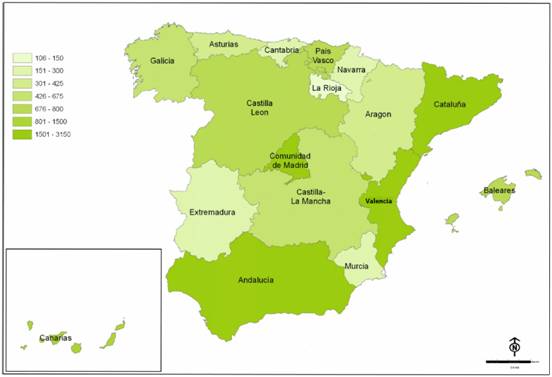
As we can observe in the Graphic, most of the establishments are to be found in Madrid (18.6%), followed by Andalusia (17.5%) and Catalonia (16.9%) These are followed by Valencia (9.2%) and the Canary Islands (8.0%). Therefore, we can observe a concentration of establishments in terms of their distribution in the various Autonomous Communities; henceforth the Communities of Madrid, Andalusia and Catalonia represent 53.0% of the total number of travel agency establishments.
In terms of the number of employees at these premises or establishments, it must be pointed out that 39.3% did not have any employees, but were run directly by the employer, whilst 31.4% had 1 or 2 employees (Graphic 2). Therefore, we can observe that the company structure of the establishments is characterized by being strongly atomized (a lot of establishments with few employees).
Graphic 2. Number of employees in establishments (2009).
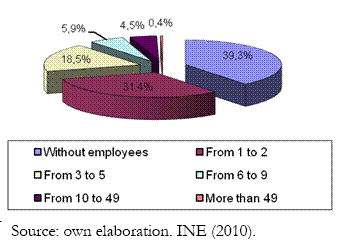
When coming to analyse the company structure of travel agencies, it is also important to have a look at how old the businesses are within this industry. As is shown in Graphic 3, which is based on a project about travel agencies created in 2003, 10.4% of the companies are 1 or 2 years old, whilst 89.6% of them are more than 2 years old.
Graphic 3. Age of travel agencies in Spain.
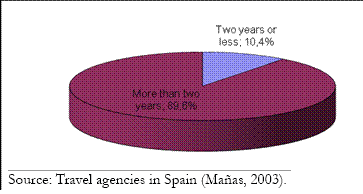
Finally, according to the Annual Services Survey 2007 (Encuesta Anual de Servicios 2007) from the Spanish National Institute of Statistics (Instituto Nacional de Estadística de España) (INE), travel agencies generated in 2007, a business value worth 18827923, 5.4% more than the previous year. Regarding production, in 2007 this totaled 4111925, 6.0% more than the previous year (Table 1).
Table 1. Accounts of the travel agency industry in Spain (thousands of euros).
| Business value Production value | 18827923 4111925 |
Source: INE (2010).
It must be pointed out that the travel agency industry is concentrated in Autonomous Communities, with an atomized company structure and a supply consisting of a great number of small companies, although being one of the most important components of Spanish financial growth.
3. Characteristics and perspectives of travel agency franchises
Undoubtedly, franchises have grown in recent decades in many countries. In Spain, the franchise system saw an important growth from the mid 90s onwards. The celebration of various franchise fairs, the publishing of books and specialized magazines, as well as the publicity carried out by franchised companies, are some of the indicators of growth in this commercial system. Nowadays, franchising in Spain finds itself consolidated by great business networks and by very high levels of revenue.
Unlike previous years, the tendency in the next years is that of a smaller growth of projects, but of a greater professional character and, in the same way, a smaller number of franchisees, but with a very high level of satisfaction. In general, it is a question of exhibiting a better preparation at all levels in order to grow and spread to other markets (Barbadillo, 2004).
The travel agency industry, which operates under the franchise system, has experienced a very high growth rate. This astronomical growth and the global crisis have resulted both in many travel agencies closing down, as well as in the stimulation of a restructuring process where new marketing strategies are developed.
Since travel agency franchises first appeared between the late 70s and the early 80s, there has been an increase in the creation of chains and establishments.
The travel agency industry under the franchising system was formed (in 2009) from a total of 42 chains and 5095 establishments, according to the data supplied by Tormo & Associates Consulting (2010). We can see that the number of chains has trebled since 1997 to 42 in 2009 (Graphic 4).
Graphic 4. Evolution of travel agency franchisors in Spain.
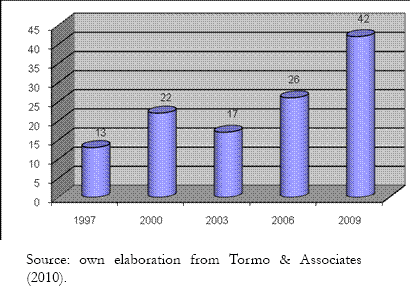
If we analyze the evolution of the number of travel agencies, we can see that there has been a significant increase since the late 90s until now, with a current figure of 5095 establishments (Graphic 5), which implies a spectacular growth in this last decade. In this way, we can appreciate that this industry is characterized as having a business structure with a low number of chains, but a very high number of establishments.
Graphic 5. Evolution of travel agency franchisees in Spain.
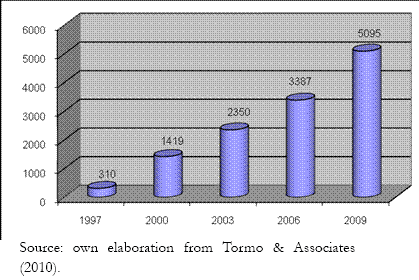
The main characteristics of a commercial establishment within the travel agency franchise industry are explained in Table 2.
Table 2. Typical commercial establishment of travel agency franchises in Spain.
| Business established Franchising since Initial investment Entry fee1 Royalty Advertising fee Contract length Minimum dimensions Minimum personal Minimum population | Alter the late 80 Alter the late 90 22834 8377 1.65% 0.97% 5 years 30 m2 1 – 2 employees 5000 residents |
1. In most cases, entry fee is included in initial investment.
Source: own elaboration.
The analysis of data of travel agencies, operating within the franchising system, yields the following affirmations:
· Within this industry, the degree of trust in the franchise is quite high, as can be seen by the fact that the ratio of franchised units versus the number of owned units provides us with high figures. The reason for this is that most of the agencies own between 1-18 commercial establishments, as well as between 14-185 franchisees.
· People can join them investing little money, as 50% of commercial establishments require an initial investment of between 7990 and 20000.
· The entry fee required by 50% of franchisors is between 4500 and 9000, but most franchisors include this entry fee in the initial investment required.
· The monthly royalty is 1.65% of total sales and the advertising fee is normally 0.97%, but many franchisors do not require this latter payment.
· The length of the contract is 5 years, but nowadays many franchisors offer indefinite contracts.
· 50% of franchisors estimate the initial invoice to be between 352500 and 465000, which are quite high business figures.
· Commercial establishments do not need to be very big, as half of franchisors demand commercial establishments between 25 and 40 square metres.
· There has been a tendency in recent years to open establishments in areas with a small population (50% of franchisors call for populations between 5000 and 13,500 residents).
· Most commercial spaces are managed by 1 or 2 employees.
· They are normally Spanish companies whose network of franchises was created after the late 90s.
By looking at the number of franchised establishments owned by each chain, we can observe that Zafiro Tours is the one, which owns the most with 700, followed by Sercom (500) Grupo Glauka ( 400), Viajes Ecuador (over 350) and Almeida Viajes (over 300) (Graphic 6).
Graphic 6. Number of franchisees in travel agency franchisors in Spain.
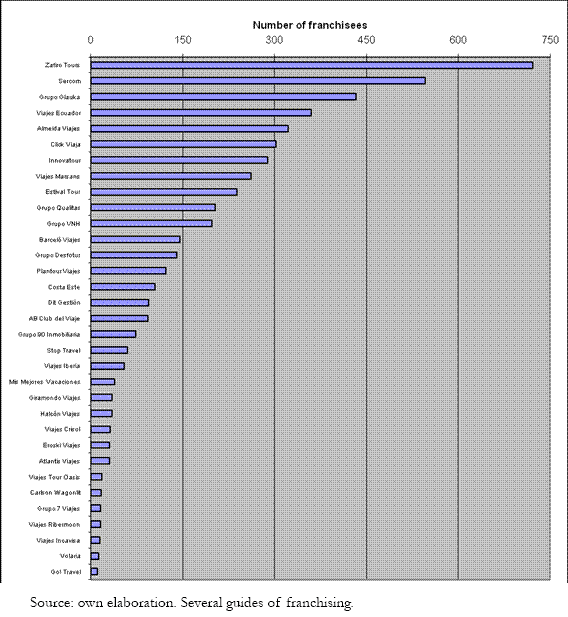
Zafiro Tours is the chain with the greatest number of franchisees, and it presents the highest growth rate in the industry. This brand specializes in organizing trips, developing its work in management, both as a retailer and wholesaler.
Sercom is another chain, which is characterized by a high number of franchisees. It began in 1994 and adopted franchises in 2000. Secom has diversified its business, from a communication and marketing company to a company specializing in investments.
Travel agencies within the Glauka Group began operating in 1997 and nowadays have a very wide network. This has been made possible, partly due to the low inversion of 3,500.
Viajes Ecuador is a company founded in 1959, which began to operate under the franchise system in 1996, taking advantage of its long experience. Franchises are provided with the latest technologies for the development of their business.
Almeida Viajes is another chain which has grown to currently become one of the most successful companies in the market. It is present in countries such as Portugal, Chile and México. Almeida Viajes Cuenta has a specialized platform for business clients and has its own search engine for flights.
The movement, which has most had an impact on the industry was begun by Halcón Viajes, which, after a long history of operating through its own agencies, opened itself up to franchising in 2009, incorporating into its network 35 franchises of Viajes Geishes, after reaching an agreement. Some experts consider the current tendency of the industry to be that of concentration and agreements between companies (Franquiciashoy, 2010).
4. Strategic groups of travel agencies in franchising
We have used the strategic dimensions and the operative variables in table 3 in order to identify whether there are different chains in the travel agency industry constituting different strategic groups. They have been previously used in other studies (Carney and Gejdalovic, 1991; Díez et al., 2005; Ramírez et al., 2007; Rondán et al., 2006; Rondán et al., 2007).
Table 3. Strategic dimensions and operative variables.
| Strategic Dimensions | Operative Variables |
| A. Size | 01. Number of outlets of the chain in the world |
| B. Dispersion | 02. Percentage of outlets located in Spain compared to the whole chain |
| C. Growth | 03. Outlets opened per year (total Outlets /age in years) |
| 04. Outlets opened per year from the beginning of the franchising system (franchised units in Spain / years franchising) | |
| D. Cost of adhesion (price of franchising) | 05. Average investment that the candidate needs to be a franchisee |
| 06. Entry Fee | |
| 07. Royalty (percentage of sales) | |
| 08. Advertising fee (percentage of sales) | |
| E. Contract | 09. Contract length (years) |
| F. Vertical integration | 10. Percentage of franchised units (confidence in franchising) |
| G. Timing | 11. Age of the company (Years since inception) |
| 12. Years franchising | |
| 13. Years not franchising (Years between inception and firs franchise) |
A strategic group can be defined as a set of companies that, within a sector of activity or industry, develops a similar strategy from its strategic dimensions (Porter, 1979). It does not mean that they should have an identical performance (Combs et al., 2004), since they can differ in respect to the resources, skills or capacities possessed (Thomas and Carroll, 1994; McNamara et al., 2003).
As Nath and Gruca (1997) indicate, the identification of strategic groups in any sector of activity can be done following factor analysis and grouping information from archive data. This methodology has been also chosen by Carney and Gedajlovic (1991), Castrogiovanni et al (1995) and Lopez and Ventura (2001).
The database used in this study has been taken from of the Spanish Consultant Tormo & Associates. Its made up from 42 chains, which form part of the travel agency industry and operating under the franchise system in Spain. We have used PASW Statistics 18 for applying the factor analysis.
4.1. Results
The statistician KMO provides us with the value 0.518, so there is an alignment of the data to a factor analysis model. Regarding Barletts sphericity test, we can also state that there is a correlation between variables. Thus it makes sense to apply factor analysis.
In order to extract the number of factors, we have focused on the criteria of selection of those factors with eigenvalues higher than 1. The extraction method used has been that of main components with varimax rotation. In our case, we have taken 4 factors that explain 71.88% of the variance total. Table 4 shows the correlations between the factors and the original variables. The highest correlations are highlighted.
Table 4. Factor analysis with varimax rotation.
|
| Component | |||
| 1 | 2 | 3 | 4 | |
| VAR01 | 0.703 | 0.593 | 0.134 | 0.197 |
| VAR02 | -0.756 | 0.044 | 0.464 | 0.015 |
| VAR03 | 0.139 | 0.820 | -0.297 | -0.205 |
| VAR04 | -0.054 | 0.963 | 0.031 | -0.034 |
| VAR05 | 0.378 | -0.284 | 0.674 | -0.044 |
| VAR06 | 0.442 | 0.034 | 0.464 | -0.226 |
| VAR07 | 0.053 | 0.011 | 0.657 | 0.305 |
| VAR08 | 0.029 | -0.196 | 0.636 | -0.168 |
| VAR09 | -0.171 | 0.713 | -0.149 | 0.027 |
| VAR10 | -0.717 | 0.362 | -0.207 | 0.270 |
| VAR11 | 0.782 | -0.021 | 0.319 | 0.439 |
| VAR12 | 0.113 | -0.089 | -0.057 | 0.815 |
| VAR13 | 0.796 | -0.003 | 0.347 | 0.292 |
The first factor is correlated with variables 11 (age of the company) and 13 (years not franchising). It is called franchise converts Carney and Gejdalovic, 1991; Castrogiovanni et al., 1995; Rondán et al., 2006), which have developed a strategy of chains (own units) during a long period of time and recently have adopted franchising as a strategy of growth. As we can see in Graphic 7, the oldest chains such as Carlson Wagonlit, Giramondo Viajes, Viajes Marsans, Viajes Iberia, Halcón Viajes and Barceló Viajes are within this group, whereas other companies that work as chains are more recent.
Graphic 7. Factorial regression between factor 1 and factor 2.
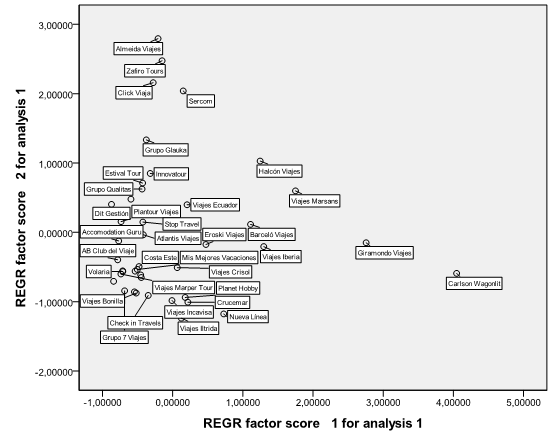
The second factor is correlated with variables 3 (outlets opened per year) and 4 (outlets opened per year from the beginning of the franchising system). This factor was termed by Carney and Gejdalovic (1991), Díez et al. (2005) and Rondán et al (2006) rapid growers. This refers to companies whose strategy is characterized by their search for fast growth, achieved by opening a high number of both franchised units and their own units, annually. They are young franchises, that is, franchises which have adopted the franchise system immediately. Amongst these, we highlight Almeida Viajes, Zafiro Tours, Clic Viaja and Sercom, in contrast with other chains (Graphic 7).
The third factor is correlated with variables 5 (average investment the franchisee requires), 6 (entry fee), 7 (royalty) and 8 (advertising fee). This is what Carney and Gejdalovic (1991), Díez et al. (2005) and Rondán et al (2006) termed conservative and expensive franchisors. They are franchisors, which require a high cost of membership, because the values of the initial investment, the entry fee and advertising fees are the highest of all. They are termed conservative because the duration of the contract is the greatest. Viajes Marsans, Grupo 90 Inmobiliaria, Barceló Viajes, Crucemar and Halcón Viajes are to be found within this group (Graphic 8).
Graphic 8. Factorial regression between factor 1 and factor 3
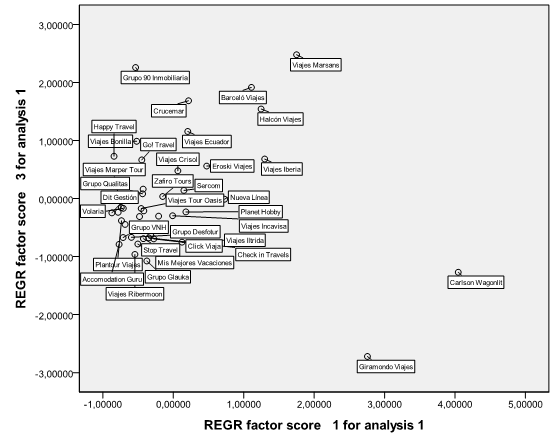
The last factor shows those chains which have been franchising for a longer period of time. This is what Carney and Gejdalovic (1991), Castrogiovanni et al. (1995), Díez et al. (2005) and Rondán et al (2006) term mature franchisors. It refers to a group of franchisors, which have been under the franchise system for longer. This has meant that in some cases they present a high number of franchised establishments. Amongst these, we highlight: Grupo VNH, Grupo 7 Viajes, Viajes Ecuador and Carlson Wagonlit.
5. Conclusions and future research
Franchise is an important commercial system for travel agencies. It allows them to increase their national presence by opening new outlets. In spite of its importance, further research is necessary in order to identify their strengths and weaknesses.
The aim of this work was to show a radiograph of travel agencies franchises. Also, we have identified several strategic groups within the travel agency industry, operating under the franchise system. For this purpose we have selected data from a developed franchise system, as is the case of Spain.
The utility of this study is to serve as a kind of orientation for both franchisors and franchisees. This study may prove useful to potential franchisees who wish to join a franchise chain. It may be used to facilitate the choice of the franchisor. From the point of view of franchisors, this study allows them to obtain a clear view of the market situation of travel agencies franchises. In this sense, they can modify their business strategies in this competitive environment.
The analysis of the franchisors of the travel agency industry enables us to say that these are chains which a person can join with low economic costs involved, but obtaining at the same time high benefits. It must be noted that the average investment to open a travel agency is located at an affordable level for many entrepreneurs. Another aspect to note is that to open a travel agency requires small establishments compared to the commercial spaces required in other industries. On the other hand, a travel agency offers services based on non-perishable items which need no stock, thus assuring the franchisee partner that (s)he will not lose any money. This can be translated into the fact that a travel agency with average characteristics can invoice large a quantity of business annually, according to figures within this industry.
To achieve this, two aspects are fundamental: the training of employees who are going to manage the franchised establishment and the use of new technologies in the marketing of tourist packages. Regarding the latter, the revolution that the Internet has meant for travel agencies must be noted. Internet has allowed the products of travel agencies to become known, as well as allowing them to reach a much wider audience.
Another important aspect is that travel agencies are following merger strategies in order to solve financial problems arising from the global crisis and with the idea of getting a stronger position within the competitive environment.
Also, the analysis of the travel agency industry operating under franchise has allowed us to identify four types of franchisors with their own characteristics: converted franchisors, fast growing franchisors, conservative and expensive franchisors and mature franchisors.
In a nutshell, we must state that the industry of travel agencies under franchise is one that is constantly on the move and constantly being restructured, something which requires constant observation in order to be able to obtain the tools of support, which ensure the competitiveness and also to be able to achieve the goals set out.
As a future line of investigation, a very interesting one would be the carrying out of other studies in other distinct industries, apart from that of travel agencies, which could provide us with a better understanding of the existing reality in each of them and with an aim of adjusting business parameters appropriately for the development of the franchise system and for the survival of chains.
References
BARBADILLO (2004): Guía Franquicias de España 2004, Barbadillo Asociados Consultores, S.L. Madrid (Spain).
BENJAMÍN, F.; HERVÉ, A. and APARICIO, M. del S. (2009): El sistema turístico en clave de marketing relacional: el factor relacional, Anuario Jurídico y Económico Escurialense, vol. XLII, pp. 419-442.
CARNEY, M. and GEDAJLOVIC, E. (1991): Vertical integration in franchise systems: Agency theory and resource explanations, Strategic Management Journal, nov., vol. 12, 8, pp. 607-629.
CASTROGIOVANNI, G.J.; BENNETT, N. and COMBS, J.G. (1995): Franchisor types: Reexamination and clarification, Journal of Small Business Management, vol. 33, nº 1, pp. 45-55.
COMBS, J. G.; KETCHEN, D. J. and HOONVER, V. L. (2004): A strategy groups approach to the franchising-performance relationship, Journal of Business Venturing, vol. 19, nº 6, pp. 877-897.
DÍEZ, E. C.; NAVARRO, A. and RONDÁN, F. J. (2005): Strategic groups in the Spanish franchising system, en Simultaneidad decisional y multifocalidad empresarial, Oleiros (A Coruña), González y Terceño, pp. 257-270.
ESTEBAN ALBERDI, C. and RUBIO ANDRADA, L. (2004): La calidad en las agencias de viajes ante el reto de la Innovación tecnológica, Electronic review Tribuna de debate, Universidad Autónoma de Madrid (Spain).
FRANQUICIASHOY (2008): Agencias de viajes: Pasaporte hacia la independencia, in www.franquiciashoy.es.
FRANQUICIASHOY (2010): Agencias de viajes en franquicia, un sector en continuo movimiento, in www.franquiciashoy.es.
KANDAMPULLY, J. (1995): Tourism in the South West: Present Posibilitéis and Future Projections, The Journal of Interdisciplinary Economics, vol. 6, pp. 169-181.
KANDAMPULLY, J. (2000): The Impact of Demand Fluctuation on the Quality of Service: A Tourism Industry Example, Managing Service Quality, vol. 10, nº 1, pp. 10-18.
LÓPEZ, B. and VENTURA, J. (2001): Grupos estratégicos en las franquicias españolas, Economía industrial, vol. 340, nº 4, pp. 163-176. [ Links ]
MAÑAS FRANCO, J. C. (2003): Las Agencias de Viajes en España: Estudio de los cambios productivos, evolución del sector y nuevas calificaciones profesionales. Proyecto de investigación realizado por la Unión Nacional de Agencias de Viajes (UNAV), financiado por la Fundación Tripartita para la Formación en el Empleo (FTFE) y Fondo Social Europeo (FSE), Spain.
MCNAMARA, G.; DEEPHOUSE, D.L. and LUCE, R.A. (2003): Competitive positioning within and across a strategic group structure: the performance of core, secondary, and solitary firms, Strategic Management Journal, vol. 24, nº 2, pp. 161-174.
NATH, D. and GRUCA, T. (1997): Convergence across alternative methods for forming strategic groups, Strategic Management Journal, vol. 18, nº 9, pp. 745-760.
PORTER, M. (1980): Competitive Strategy, Free Press, Nueva York.
RAMÍREZ, J.M. (2004): Caracterización de las agencias de viajes que operan bajo el sistema de franquicia en España, I Congreso Internacional sobre Patrimonio, Desarrollo rural y Turismo en el Siglo XXI, Osuna, Spain.
RAMÍREZ, J.M.; RONDÁN, F.J. and DÍEZ, E.C (2007): Tipologías de franquiciadores a través del análisis cluster, XVII Jornadas Hispano Lusas de Gestión Científica, Logroño, Spain.
RONDÁN, J.; NAVARRO, A. y DÍEZ, E. C. (2006): Strategic groups: the case of the spanish franchising, 5th International Congress Marketing Trends, Venice, Italy.
RONDÁN, J.; NAVARRO, A. y DÍEZ, E. C. (2007): Proposing New Variables for the Identification of Strategic Groups in Franchising, International Entrepreneurship and Management Journal, vol. 3. nº 4, pp. 355-377.
THOMAS, H. and CARROLL, C. (1994): Theoretical and empirical links between strategic groups, cognitive communities, and networks of interacting firms, in Daems, H. and Thomas, H. eds., Strategics groups, strategic movies and performance. Pergamon, Tarry-town, New York, pp. 7-29.
TORMO & ASOCIADOS (2004): Informe sectorial. Agencias de viajes, Madrid, Spain.
WTO – World Tourism Organization (1998): Introduction to tourism, Madrid.
Submitted: 23.06.2010
Accepted: 15.11.2010













